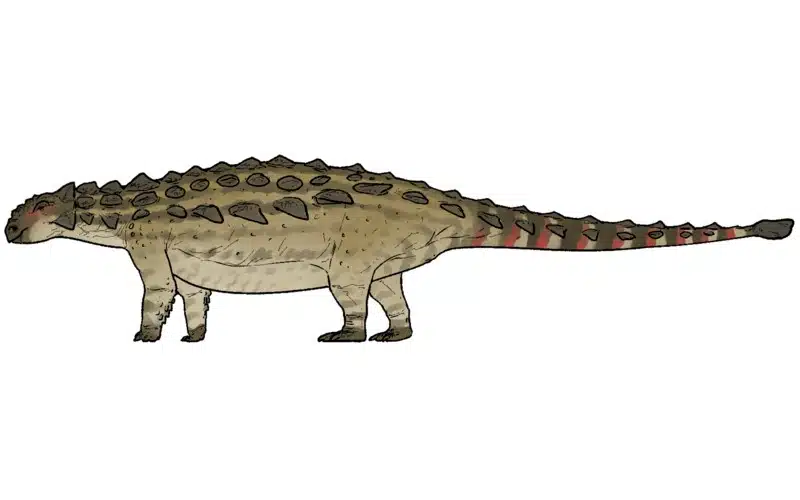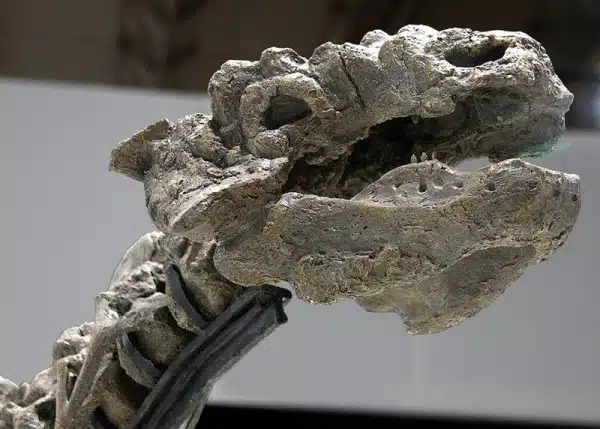Imagine a heavily armored dinosaur ambling through the parched valleys of Late Cretaceous China, its bony plates glinting under the sun—this was Tianzhenosaurus. First discovered in Tianzhen County, Shanxi Province, this fascinating herbivore provides valuable insights into ankylosaur diversity, evolution, and ecology. Known for its armored body and herbivorous diet, Tianzhenosaurus lived approximately 99–71 million years ago, sometime during the Cenomanian-Campanian Epochs of the Late Cretaceous.
This dinosaur’s name, which translates to “Tianzhen Lizard,” pays homage to its discovery location and its lineage. Despite being less well-known than some of its ankylosaurian relatives, this dinosaur offers a glimpse into a unique period of Earth’s history when armored giants roamed the land alongside other iconic species.
Tianzhenosaurus Key Facts
| Keyword | Fact |
|---|---|
| Pronunciation | tyan-ZHEN-oh-SAW-rus |
| Meaning of name | Tianzhen Lizard |
| Group | Ankylosauria |
| Type Species | Tianzhenosaurus chengi |
| Subspecies | Tianzhenosaurus youngi |
| Diet | Herbivore |
| When it Lived | ~99–71 mya |
| Period | Late Cretaceous |
| Epoch | Cenomanian-Campanian |
| Length | Not specified |
| Height | Not specified |
| Weight | Not specified |
| Mobility | Moved on all four legs |
| First Discovery | 1983, by Pang Qiqing and Cheng Zhengwu |
| Described by | 1998, by Pang Qiqing and Cheng Zhengwu |
| Holotype | HBV-10004 |
| Location of first find | Wu Valley, Kangdailiang near Zhaojiagou Village, Tianzhen County, Shanxi Province, China |
| Also found in | Mongolia |
Tianzhenosaurus Origins, Taxonomy, and Timeline
Tianzhenosaurus derives its name from the location of its discovery, Tianzhen County, Shanxi Province, China. The latter part of its name, “saurus,” is Greek for “lizard,” a common suffix for many dinosaur names. This etymology highlights its geographic roots and underscores the convention of combining Greek or Latin elements with local names to christen new species.

Tianzhenosaurus is generally resolved as part of the Ankylosaurid family, a derived clade of ankylosaurs known for their distinctive armor and club-like tails. So far two species have been named: the first, Tianzhenosaurus youngi, named for the famed Chinese palaeontologist “C. C. Young”, and the more recent addition to the genus: Tianzhenosaurus chengi. The specific diversity within the Tianzhenosaurus genus undoubtedly reflects the taxonomic abundance of Asian ankylosaurs during this period.
Tianzhenosaurus roamed sometime during the Cenomanian-Campanian epochs of the Late Cretaceous Period, approximately 99–71 mya million years ago. This span of time – far greater than any one species is likely to exist – reflects ongoing uncertainties regarding the age of the formation (Huiquanpu) in which the dino was found. Nonetheless, this time frame situates Tianzhenosaurus within a dynamic evolutionary period, characterized by flourishing dinosaur diversity and significant ecological interactions. The Late Cretaceous also witnessed the rise to prominence of flowering plants, offering abundant food sources for herbivores like this armored dinosaur.
Discovery & Fossil Evidence
The first fossil evidence of Tianzhenosaurus was unearthed in 1983 by paleontologists Pang Qiqing and Cheng Zhengwu in Wu Valley, Kangdailiang near Zhaojiagou Village, Tianzhen County, Shanxi Province, China. These discoveries laid the groundwork for further understanding this fascinating ankylosaur. Nonetheless, debate would circulate regarding the validity of this taxon in the subsequent years – with some paleontologists suggesting it is synonymous with the Mongolian form Saichania. However, if this was the case we would expect to see the two dinos resolved as sister-taxa in the cladistic analyses that have included them – but this does not appear to have been the case!
In 2024, the validity of Tianzhenosaurus was further cemented with the introduction of Tianzhenosaurus chengi, officially described by Pang Qiqing, Li Zhiguang, and Guo Zhen. This description was based on the holotype HBV-10004, a well-preserved skull, and the paratype HBV-10005, a nearly complete skeleton. Several distinctive cranial features set this dinosaur apart from other Asian ankylosaurids such as Saichania, Talarurus, and Shanxia. These specimens were found in the same rock layers as Tianzhenosaurus youngi, offering insights into the genus’s diversity.
- Skeleton of the ankylosaurid Tianzhenosaurus
- Tianzhenosaurus skull in Japan
- Reconstructed skeleton mount of T. youngi
- Reconstructed skull of T. youngi
Tianzhenosaurus Size and Description
Short Description of Tianzhenosaurus
This ankylosaurid is noted for its heavy armor and stocky build, traits typical of its clade. Its body was likely broad and low to the ground, supported by four sturdy legs. Its head featured a beak-like structure for cropping vegetation, while its tail, like all ankylosaurids, ended in a body club, likely to have played a role in defense. Covered in bony osteoderms, it was well-protected against predators. Tianzhenosaurus moved on all fours, making it a slow but steady herbivore that relied on its armor for survival.
Size and Weight of Type Species
Exact measurements for Tianzhenosaurus remain elusive, as no complete skeleton has been discovered. However, comparisons with other ankylosaurids suggest a length of approximately 20.0 to 25.0 feet, a height of around 5.0 to 6.0 feet, and a weight ranging from 3.0 to 5.0 tons. Future discoveries may refine these estimates, but for now, it is understood to have been a medium-sized member of its family.
The Dinosaur in Detail
Tianzhenosaurus was a heavily armored dinosaur, recognizable by its low, triangular skull and rugged surface covered with bony tubercles. Its unique skull had long premaxillae, horizontally stretched nasal openings, and small eye sockets surrounded by bony rings. The lower jaw was deep and unornamented, with tooth rows that converged slightly toward the back. The creature’s body featured robust vertebrae, including short neck bones and elongated tail vertebrae, ending in a distinctive tail club that likely served as a powerful defensive weapon.
Paleontologists have noted similarities between Tianzhenosaurus and other ankylosaurids like Saichania and Ankylosaurus. Its skull shape and bony scutes mirrored Saichania’s, while other features, such as the transversely widened occipital condyle and diverging tooth rows, were akin to Ankylosaurus. Despite these resemblances, Tianzhenosaurus had unique traits, such as the angle and degree of coverage of dermal tubercles over the skull, making it a distinct member of its family and a formidable presence in its Late Cretaceous environment.
Contemporary Dinosaurs
Sharing its ancient world with Tianzhenosaurus was the agile Gobivenator, a small theropod known for its swift movements and predatory habits. With a carnivorous diet focused on smaller creatures, this fleet-footed predator roamed the same landscapes but avoided direct competition with the armored herbivore by targeting different prey.
Another fascinating cohabitant was the Oviraptor, a distinctive theropod with a beak-like mouth. This versatile dinosaur thrived on an omnivorous diet, feasting on seeds, fruits, and occasionally eggs. Its adaptability allowed it to coexist with Tianzhenosaurus while occupying a complementary ecological niche.
Adding to the diversity of the Late Cretaceous ecosystem was Bactrosaurus, a hadrosaurid dinosaur. Like Tianzhenosaurus, it was an herbivore, but its preference for a different selection of vegetation reduced any potential competition for food, ensuring a balanced sharing of the lush resources.
Gallimimus, the ostrich-like sprinter of the era, also played its part in this vibrant environment. Known for its remarkable speed, it survived on a diet that included plants and small invertebrates. Its lightweight frame and quick reflexes provided a stark contrast to the heavily armored and slow-moving Tianzhenosaurus, showcasing the incredible variety of life forms that coexisted during this time.
Interesting Points about Tianzhenosaurus
- Tianzhenosaurus was named after Tianzhen County, Shanxi Province, highlighting the regional significance of paleontological discoveries in this area.
- The distinctive isosceles triangle-shaped skull, along with its unique pattern of bony tubercles and scutes, sets it apart from other ankylosaurids.
- Its fossils, including a nearly complete skeleton and a skull, have been found in both China and Mongolia, indicating a broader geographic range than initially thought.
- The anatomical similarities to Saichania and Ankylosaurus, alongside its unique traits, provide valuable insights into the diversity and evolution of ankylosaurids in Asia.
- Tianzhenosaurus lived in a dynamic Late Cretaceous ecosystem, coexisting with a variety of species, from swift theropods like Gobivenator to herbivorous dinosaurs such as Bactrosaurus.
Tianzhenosaurus in its Natural Habitat
Tianzhenosaurus thrived in a temperate environment criss-crossed by rivers and dominated by lush vegetation. The climate was likely warm and humid, fostering the growth of ferns, cycads, and conifers. These plants provided ample food for this herbivore.
Its diet consisted of tough, fibrous plants that it cropped with its beak. The dinosaur’s slow movement and heavy armor suggest it lived a solitary or semi-solitary lifestyle, avoiding predators through defense rather than speed.
As a large herbivore, Tianzhenosaurus would have influenced its environment by shaping vegetation and creating pathways. Its role in the ecosystem likely supported other species, including smaller herbivores and the predators that hunted them.
Frequently Asked Questions
Tianzhenosaurus was an ankylosaurid, a type of armored dinosaur known for its bony plates and herbivorous diet.
It was first discovered in Tianzhen County, Shanxi Province, China, in 1983.
This dinosaur fed on low-lying vegetation, including ferns, cycads, and conifers.
While exact measurements are uncertain, estimates suggest it was about 20.0 to 25.0 feet long and weighed 3.0 to 5.0 tons.
It lived during the Late Cretaceous. Although its precise temporal span is uncertain, it flourished between approximately 99 to 71 million years ago.
Predators of its time likely included smaller theropods like Gobivenator, though its armor provided significant protection.
Sources
The information in this article is based on various sources, drawing on scientific research, fossil evidence, and expert analysis. The aim is to provide a comprehensive and accurate overview of Tianzhenosaurus. However, please be aware that our understanding of dinosaurs and their world is constantly evolving as new discoveries are made.
This article was last fact checked: Joey Arboleda, 01-13-2024
Featured Image Credit: Ddinodan, CC BY 4.0, via Wikimedia Commons




